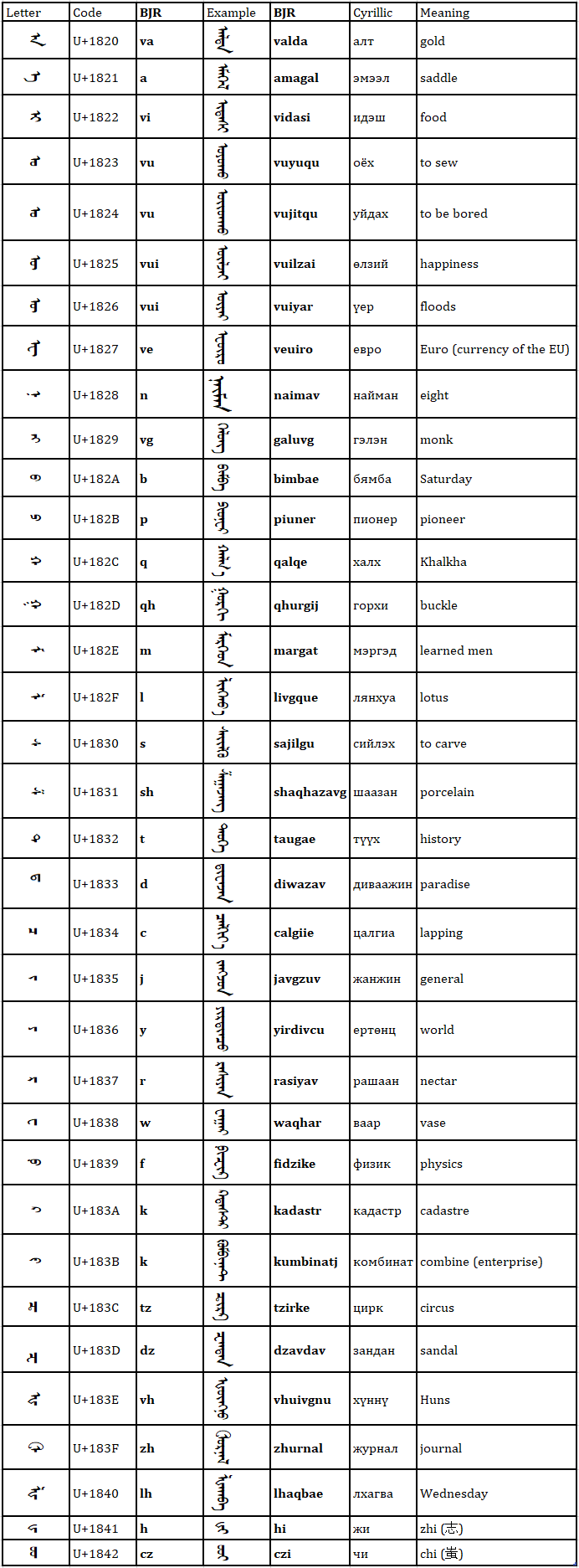Ostasien
Mongolian
Staatsbibliothek zu Berlin uses a transliteration system for the Mongolian script which was developed by Michael Balk and Juha Janhunen. "Balk Janhunen Romanization" (BJR) is a true transliteration. Transcription systems widely used in Mongolian studies – such as the one applied by Nikolas Poppe in his "Grammar of written Mongolian" – are based on the assumption of a specific pronunciation of individual letters within certain words. In contrast, BJR reproduces the basic graphic elements of the Mongolian script in their functionality within the alphabetical logic of writing. All characters of the original script are expressed in Latin letters or letter combinations without diacritics according to the principle of a bijective function, thereby taking into account positional variability (initial, medial, final and isolated). Assumptions regarding the articulation of certain vowels or consonants are avoided. The glyphs of the Mongolian script are interpreted only in terms of whether they are meant to be vowels or consonants; exactly which vowels or consonants are involved in a pronunciation is only noted in BJR to the extent that it is noted in the original spelling itself.
For a detailed introduction and presentation of BJR, please consult the bibliography at the end. Below you will find a brief overview of this romanisation according to the arrangement of the Mongolian alphabet in the currently valid Unicode encoding. The examples provided may illustrate the actual functioning of BJR:

Notes
No distinction is made in the romanisation with regard to the vowel harmony (such as a versus e) unless it is expressed in the script itself (as in u versus ui in first-syllable appearances). BJR does also not adhere to the transcriptional distinction between o and u and the like unless it is marked (rarely in final position, cf. vuyuqu versus veuiro). Words that are commonly considered vocalic in their onset actually begin with consonantal aleph, typical of Semitic scriptural traditions, romanised by v (appearing in va- vi- vu- ve-). In words like amagal, where the initial aleph is followed by a consonant, the initial is interpreted as the vowel a in the romanisation. A number of particles (aca i ijar ijav u uu uv ut e) also show other initial genuine vowels.
Glyphs such as the so-called "tooth" (sidu = шүд) or the "shin" (silbij = шилбэ) may imply a vocalic or a consonantal interpretation, depending on position and alphabetical function within a word. In such cases a i e represent the vocalic and v j w the consonantal side of the same grapheme. Apart from functioning as indication of a following vowel at the beginning of a word, v can also appear at the end of a closed syllable, in which case it represents a non-dotted spelling of the dental nasal.
Vowel combinations can consist of two vowels, as can be seen from examples such as vuilzai or naimav. In three-character combinations a middle intervocalic glyph is interpreted as a consonant if possible, hence sajilgu and vujitqu but veuiro. Please note the difference in spelling in words such as ᠰᠠᠶᠢᠬᠠᠨ sajiqav "beautiful" [сайхан] versus ᠰᠠᠶ᠋ᠢᠬᠠᠨsayiqav "recently" [саяхан].
Final e can appear as bound (directly connected) or unbound letter (unconnected, showing a blank or space before e in the Mongol script). In the latter case, the space can normally be omitted in the romanisation because it is evident from the preceding consonant whether e shall be written connected (bimbae, taugae, fidzike) or not (amune, qalqe, livgque, calgiie). In all non-final positions e represents the medial vowel that Unicode encoded as U+1827 (as in veuiro and piuner).
Another sign that deserves mention is the so-called "hook" (tagagae = дэгээ) which can only appear at the end of a word. It is romanised by j and can appear after a vowel as in qhurgij "brook" [горхи] or after certain consonants which do not themselves possess a final form in their own right such as t in kumbinatj. Common words with a closing "hook" not present in the table are bij "I" [би] or suj "milk" [сүү]. Due to its sole occurrence in a final position, the romanisation of the "hook" is clearly distinguishable from other semantics of j such as the initial (javgzuv) or the intervocalic letter (vujitqu, sajilgu) it may refer to.
In actual printing, U+183A (ᠺ) and U+183B (ᠻ) are hardly distinguished. Both letters usually correspond to Cyrillic к in loanwords. Older publications tend to use U+183B (ᠻ) exclusively, while newer ones more often show U+183A (ᠺ). Databases like mongoltoli use only one letter and ignore the other one completely. Staatsbibliothek zu Berlin decided many years ago to romanise the two letters as one and the same letter because they appear to be arbitrary. In pre-modern Galig, U+183B (ᠻ) seems to be rather absent, while U+183A (ᠺ) can correspond to two Tibetan letters in the Mongolian Script, namely kh (ཁ) and g (ག).
Literature
Balk, Michael (2012): Sieben Strophen des Udānavarga in mongolischer Version“ in Per Urales ad Orientem : iter polyphonicum multilingue ; festskrift tillägnad Juha Janhunen på hans sextioårsdag den 12 februari 2012; Helsinki : Suomalais-Ugrilainen Seura, (Suomalais-Ugrilaisen Seuran toimituksia), pp. 25-37
Janhunen, Juha (2003): “Written Mongol” in The Mongolic Languages; London: Routeledge (Routledge language family series), pp. 30-56
Balk, Michael & Janhunen, Juha (1999): A new approach to the Romanisation of Written Mongol, in: Writing in the Altaic world : [proceedings of the 41st Annual Meeting of the Permanent International Altaistic Conference (PIAC)]; Helsinki: Finnish Oriental Society (Studia Orientalia 87), pp. 17-27)
